How Long Do Raw Almonds Last
Raw almonds can last up to 12 months in their original sealed packaging at room temperature, but you'll need to store them properly to achieve this shelf life. Once you've opened the package, your almonds will stay fresh for 4-6 months in an airtight container in your pantry. For extended storage, refrigeration keeps them fresh for up to a year, while freezing can preserve them for up to 2 years. You'll know your almonds have gone bad if they develop a rancid smell, bitter taste, or show signs of mold or discoloration. The key to maximizing their longevity lies in understanding proper storage techniques and environmental conditions.
This post may contain affiliate links. If you make a purchase through these links, I may earn a commission at no additional cost to you. Additionally, portions of this post may be generated using artificial intelligence (AI) technology. While we strive for accuracy, please be aware that AI-generated content may not always be perfect and should be fact-checked when necessary.
The Spatula Scoops
- Unopened factory-sealed raw almonds stay fresh for up to 12 months when stored at room temperature.
- Opened raw almonds stored in airtight containers maintain freshness for 4-6 months at room temperature.
- Bulk raw almonds in original packaging remain fresh for 3-4 months before quality begins to decline.
- Refrigerated raw almonds stored at 35-40°F in airtight containers can last 6-12 months.
- Frozen raw almonds properly stored in airtight containers can maintain quality for up to 2 years.
Raw Almond Storage Guidelines
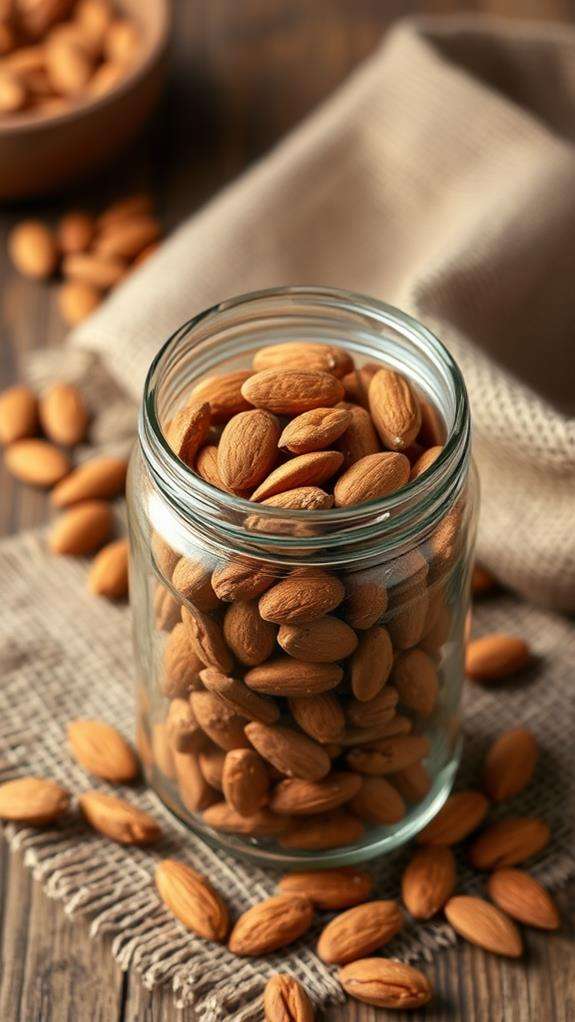
Three key factors determine proper raw almond storage: temperature, humidity, and container type. You'll need to maintain temperatures between 35-40°F (2-4°C) for ideal preservation, while keeping humidity levels below 65% to prevent moisture-related issues like mold growth and rancidity.
When it comes to containers, you'll want to choose airtight options that block out light and moisture. Glass mason jars, food-grade plastic containers, or vacuum-sealed bags work well, but you'll need to verify they're completely clean and dry before use. If you're storing large quantities, consider using food-grade storage buckets with gamma seal lids.
For long-term storage, you'll find that your raw almonds last longest when kept in the refrigerator or freezer. If you're planning to store them at room temperature, keep them in a cool, dark pantry away from heat sources and direct sunlight. Don't store your almonds near strong-smelling foods, as they can absorb odors. You should also avoid keeping them in areas prone to temperature fluctuations, like near your stove or dishwasher, as this can cause condensation and compromise quality.
Signs of Spoiled Almonds

Several telltale signs will help you determine if your raw almonds have spoiled. First, you'll want to examine their appearance – if you notice any discoloration, particularly dark spots, mold growth, or a shriveled, dried-out texture, it's time to discard them. A healthy raw almond should maintain its natural light brown color and smooth surface.
Your nose is another reliable tool for detecting spoilage. If you detect any rancid, chemical-like, or musty odors when sniffing your almonds, they've likely gone bad. Fresh almonds should have a mild, slightly sweet aroma. When you're unsure about the smell, try breaking an almond in half – rancid nuts often have a stronger odor inside.
The taste test is your final verification method, though you shouldn't eat obviously moldy nuts. If your almonds taste bitter, sour, or have a paint-like flavor, they're rancid. You might also notice a change in texture – spoiled almonds often become rubbery or extremely soft instead of maintaining their characteristic crunch. If you're storing them properly but notice any of these signs, it's best to err on the side of caution and dispose of them.
Pantry Storage Timeframes
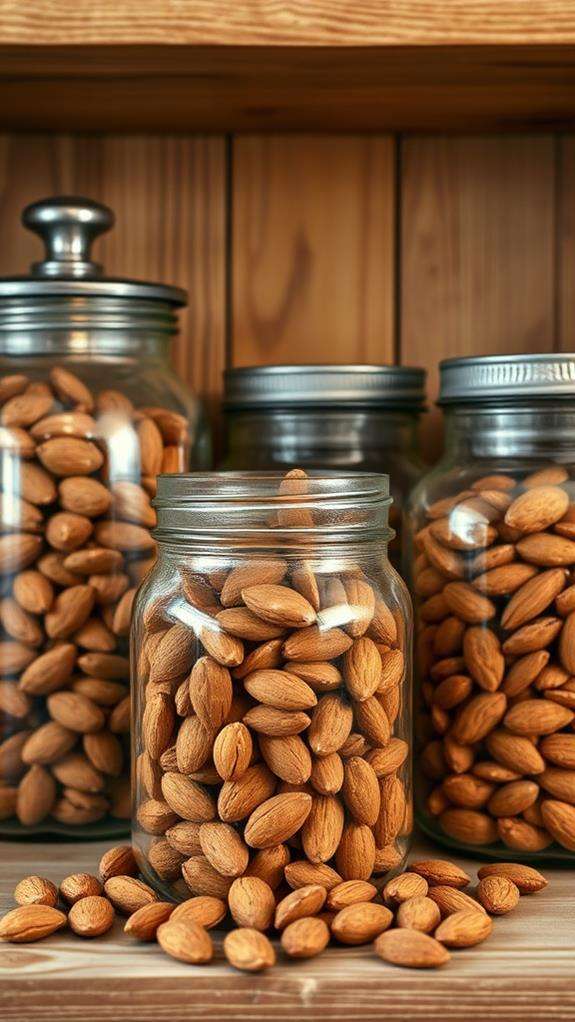
Raw almonds stored in your pantry have different shelf lives depending on their packaging condition. When you're storing unopened, factory-sealed almonds in your pantry, they'll typically maintain their quality for up to one year from the packaging date. However, once you've opened the original packaging, you'll need to be more mindful of timing and storage conditions.
- Unopened, commercially packaged raw almonds will last 12 months when stored at room temperature (68-72°F) in a dry pantry
- Opened raw almonds transferred to an airtight container can maintain freshness for 4-6 months in your pantry
- Bulk-purchased raw almonds stored in original packaging will stay fresh for 3-4 months at room temperature
You'll get the best results by storing your opened almonds in an airtight, food-grade container that's specifically designed to prevent moisture and oxygen exposure. If you've purchased almonds in bulk, you shouldn't leave them in the original plastic bag for extended periods. Instead, transfer them to proper storage containers within a few days of purchase to maximize their shelf life and maintain peak flavor profiles.
Refrigeration and Freezing Methods
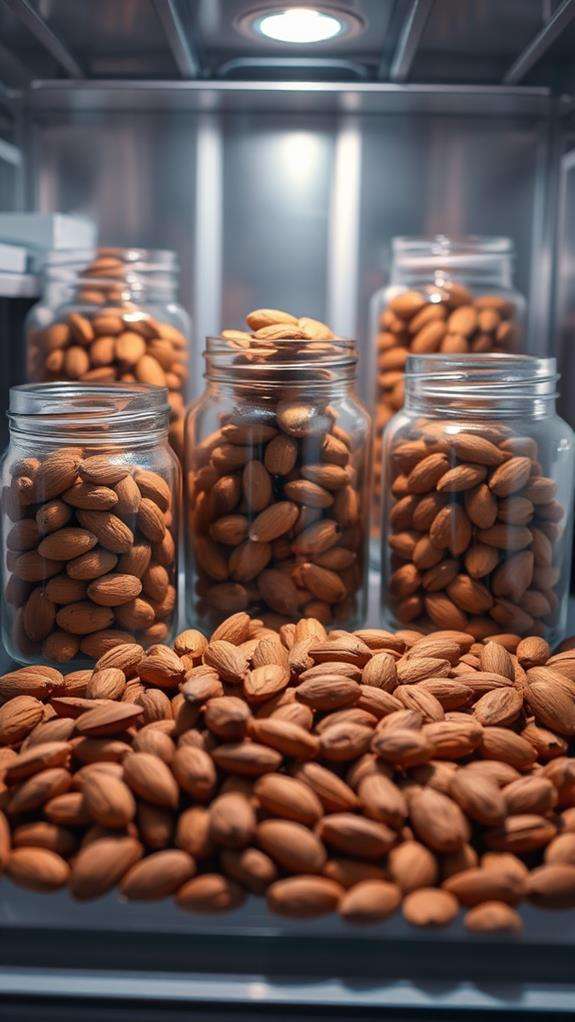
You'll get the best results storing raw almonds in your refrigerator at 35-40°F (1.6-4.4°C), which helps maintain their natural oils and prevents rancidity. For freezer storage, you should place your almonds in an airtight container or heavy-duty freezer bag, removing as much air as possible to prevent freezer burn and moisture absorption. When properly packaged and frozen at 0°F (-18°C), your raw almonds can maintain their quality for up to two years, though it's best to label the container with the storage date for easy tracking.
Optimal Refrigeration Temperature Range
Maintaining the right temperature is vital when refrigerating raw almonds. For maximum preservation, you'll want to keep your refrigerator's temperature between 35°F and 40°F (1.7°C to 4.4°C). This temperature range helps prevent moisture accumulation while slowing down the oxidation process that can lead to rancidity.
When you're storing raw almonds in your refrigerator, consider these important temperature-related factors:
- The door compartment isn't ideal for almond storage, as it experiences more temperature fluctuations when you open and close the refrigerator
- The middle shelf typically maintains the most consistent temperature, making it your best storage location
- The back of the refrigerator tends to be colder than the front, so position your almonds accordingly if you notice any freezing
Your refrigerator's humidity level also plays a key role in preservation, so you'll want to use an airtight container to protect against moisture absorption. If you notice condensation forming inside the container, it's a sign that your refrigerator's temperature might be fluctuating too much. You can monitor this using a refrigerator thermometer, which helps guarantee you're maintaining that perfect 35°F to 40°F range consistently.
Freezer Storage Best Practices
Proper freezer storage can extend raw almonds' shelf life up to two years when you follow the right methods. To maximize preservation, you'll need to store your almonds in an airtight, freezer-safe container or heavy-duty freezer bag that's specifically designed for low-temperature storage. Before sealing, remove as much air as possible to prevent freezer burn and moisture accumulation.
For the best results, you'll want to portion your almonds into serving sizes you'll actually use, as repeated thawing and refreezing can compromise their quality. Label each container with the date of freezing and expected expiration date. When storing multiple containers, place newer packages toward the back of your freezer and older ones in front to maintain proper rotation.
Make sure your freezer maintains a consistent temperature of 0°F (-18°C) or below. When you're ready to use your frozen almonds, transfer the portion you need to the refrigerator and let them thaw gradually for 24 hours. This controlled thawing process helps preserve their texture and prevents condensation from forming, which could lead to premature spoilage or texture changes.
Proper Packaging Options
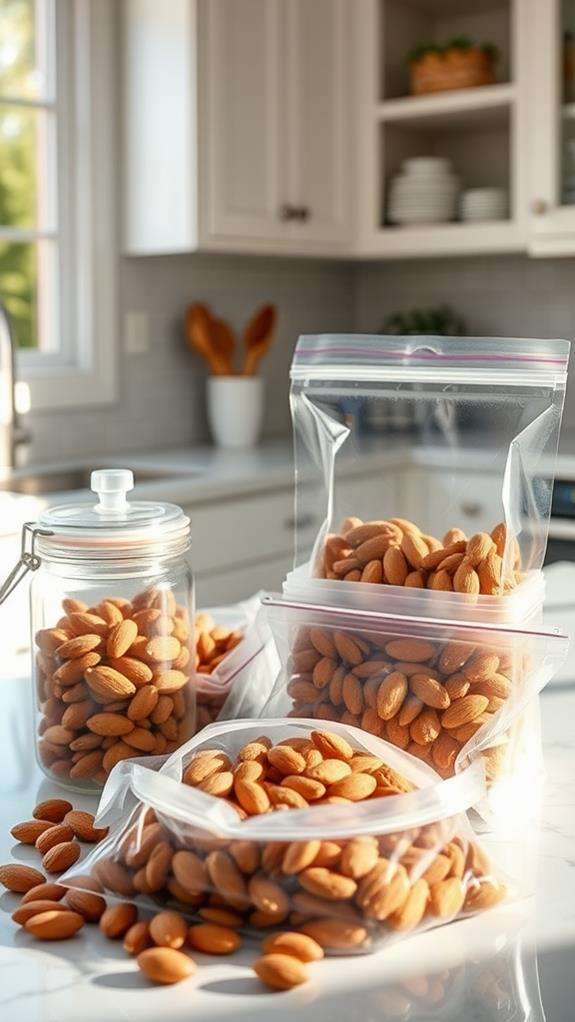
The right storage containers can make or break your almond preservation efforts. When you're storing raw almonds, you'll want to choose packaging that creates an airtight seal and prevents moisture, light, and air from reaching your nuts. Glass containers with tight-fitting lids, vacuum-sealed bags, and food-grade plastic containers with secure closures are all excellent options for maintaining freshness.
For ideal storage results, you'll need to take into account these key packaging features:
- Airtight seals that prevent oxygen infiltration, which can lead to rancidity and oxidation of the almonds' natural oils
- UV-resistant or opaque materials that protect against light exposure, which can degrade the nuts' nutritional content
- Moisture-proof barriers that keep humidity from causing mold growth or texture changes
If you're planning long-term storage, think about using vacuum-sealed bags with oxygen absorbers for maximum preservation. You can also combine methods by storing vacuum-sealed portions inside a larger airtight container. Remember to label your containers with the storage date and verify they're completely dry before adding your almonds, as any residual moisture can compromise their shelf life.
Extending Raw Almond Shelf Life

To maximize your raw almonds' shelf life, you'll need to choose an airtight container that blocks out light and moisture, such as a glass jar with a secure lid or a vacuum-sealed bag. Keeping your almonds away from heat sources and direct sunlight is essential, as temperatures above 65°F can accelerate rancidity and reduce their storage life by several months. You can further protect your almonds by maintaining proper humidity levels in your storage area, ideally between 55-65% relative humidity, which you can monitor using a simple hygrometer.
Proper Storage Container Selection
Selecting the right storage container plays an essential role in maximizing your raw almonds' shelf life. When you're choosing a container, you'll want to focus on options that provide an airtight seal and protect against moisture, light, and temperature fluctuations. Glass containers with rubber gaskets or high-quality plastic containers with snap-lock lids are your best choices for long-term storage.
- Mason jars with two-piece lids offer excellent protection and allow you to easily monitor your almonds' condition through the transparent glass.
- Food-grade plastic containers with hermetic seals prevent oxidation while being lightweight and stackable for efficient pantry organization.
- Vacuum-sealed bags remove excess air and create an ideal storage environment, particularly for bulk quantities.
You'll want to avoid containers with loose-fitting lids or those made from materials that can trap moisture. If you're using plastic containers, make sure they're BPA-free and specifically designed for food storage. Remember to select a container size that matches your typical usage patterns – you don't want too much empty space, as this can lead to unnecessary air exposure when you open the container repeatedly.
Keep Away From Heat
Heat exposure poses one of the biggest threats to raw almond freshness, as warm temperatures can accelerate rancidity and nutrient degradation. You'll want to keep your almonds away from direct sunlight, heating vents, and appliances that generate warmth, such as your stove, microwave, or dishwasher. The ideal storage temperature for raw almonds is between 35-40°F (1.7-4.4°C).
If you can't store your almonds in the refrigerator, you should at least keep them in the coolest area of your pantry or kitchen. Avoid placing them near windows where sunlight streams in, or above the stove where cooking heat rises. Temperature fluctuations can cause condensation inside storage containers, which promotes mold growth and spoilage. You'll know heat has affected your almonds if they develop a bitter, paint-like taste or smell unusually strong.
For long-term storage, you might consider using your refrigerator or freezer, where temperatures remain consistently cool. If you're storing bulk quantities, divide them into smaller portions so you're not repeatedly exposing the entire batch to room temperature when retrieving some.
Monitor Humidity Levels
Proper humidity control plays a crucial role in maintaining your raw almonds' freshness and preventing spoilage. You'll want to keep your storage environment's relative humidity between 55-65% to preserve the nuts' quality and prevent moisture-related issues. When humidity levels rise above this range, you're risking mold growth and premature rancidity, which can quickly render your almonds inedible.
To effectively monitor and control humidity levels:
- Use a digital hygrometer in your storage area to track moisture levels consistently
- Place silica gel packets or food-grade desiccants in your storage containers to absorb excess moisture
- Consider using a small dehumidifier in your pantry during particularly humid seasons
If you're storing raw almonds in regions with high humidity, you'll need to be extra vigilant. Check your storage containers weekly for any signs of condensation on the inside walls. When you notice moisture buildup, transfer your almonds to a fresh, dry container immediately. You can also store your almonds in the refrigerator, where humidity levels are typically more controlled, though you'll need to verify they're in an airtight container to prevent absorbing odors from other foods.
Temperature and Humidity Factors
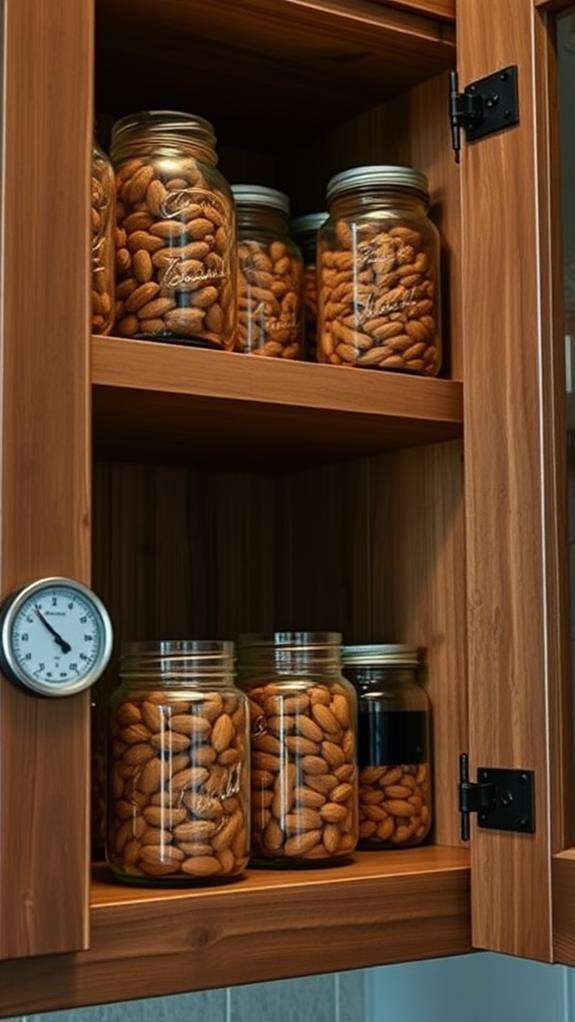
Two key environmental factors directly impact how long your raw almonds will last: temperature and humidity. You'll want to maintain temperatures between 35-40°F (1.7-4.4°C) for ideal storage, as warmer temperatures can accelerate rancidity and promote unwanted bacterial growth. Your refrigerator's crisper drawer typically provides this perfect temperature range.
Humidity levels should stay between 55-65% relative humidity (RH) to preserve your almonds' quality. When humidity's too high, you'll risk mold development and premature spoilage; too low, and your almonds might become overly dry and lose their pleasant texture. You can regulate humidity by storing your almonds in an airtight container with a reliable seal.
The relationship between temperature and humidity isn't just additive – they work synergistically. Higher temperatures amplify humidity's effects, potentially creating a microenvironment that's perfect for spoilage organisms. That's why you shouldn't store your almonds in warm, damp places like above the stove or near dishwashers. If you're planning long-term storage, consider using a food-grade desiccant packet in your storage container to help manage moisture levels while maintaining consistent temperatures.
Frequently Asked Questions
Can Raw Almonds Be Safely Consumed After They Develop a Softer Texture?
You shouldn't eat almonds that have become soft, as this change in texture often indicates spoilage or rancidity. When almonds lose their signature crunch, it's typically due to moisture exposure or oil degradation, which can lead to harmful bacterial growth and off-flavors. You'll want to immediately discard any almonds that feel soft or rubbery, as consuming them could risk food poisoning or digestive issues.
Do Almonds Need to Be Washed Before Storing Them?
You'd think almonds need washing, but surprisingly, they don't. Since they're already cleaned during processing, washing them before storage can actually introduce unwanted moisture, which may lead to mold growth. If you're still concerned, you can wipe them with a clean, dry cloth. For best storage results, just place your almonds directly in an airtight container and keep them in a cool, dry place.
Will Storing Raw Almonds With Other Nuts Affect Their Shelf Life?
You'll want to store different nuts separately, as they can affect each other's shelf life and quality. Each type of nut has unique oil content and moisture levels, which can lead to faster spoilage when mixed. If you must store them together, you'll risk your almonds absorbing odors or moisture from other nuts, potentially reducing their freshness. For best results, keep your raw almonds in their own airtight container.
Can You Refreeze Raw Almonds After Thawing Them?
Like Lazarus rising again, your almonds can indeed be refrozen after thawing, but you'll want to be mindful of a few things. You shouldn't refreeze them more than once, as this can affect their texture and taste. If you've thawed them in the fridge (not on the counter), they're safer to refreeze. Make sure they're completely dry and sealed in an airtight container to prevent freezer burn and moisture absorption.
Do Organic Raw Almonds Have a Different Shelf Life Than Conventional Ones?
Organic and conventional raw almonds don't have markedly different shelf lives when stored under the same conditions. You'll find both types last about 1-2 years in the refrigerator and up to 2 years in the freezer. The key difference isn't in their shelf life but in how they're grown and processed. You should focus more on proper storage methods – keeping them in an airtight container, away from heat and moisture – than whether they're organic or conventional.





